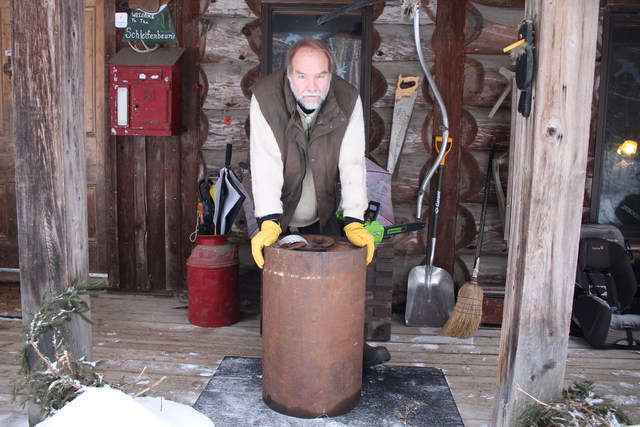Haliburton’s Peter Schleifenbaum has been reunited with one of his loves – a Second World War depth charge.
The Mark VII sits on the porch of Schleifenbaum’s home. It doesn’t look like much. However, the former owner of Haliburton Forest and Wildlife Preserve thought enough of the charge – designed to be dropped from a ship or aircraft to explode underwater – that he fought to get it back after it was confiscated by the military on Nov. 5, 2018.
The Canadian Armed Forces took it during a bomb scare at the Forest that had attracted the Ontario Provincial Police (OPP).
“I was given this very unusual piece by my predecessor as manager at Haliburton Forest, Pat Waddell,” Schleifenbaum explains.
Waddell ran the Forest from the mid1950’s until 1988, when Schleifenbaum arrived. Waddell was already more than 70 years old at that point. During the Second World War, he had joined the Canadian Navy and served on patrol vessels accompanying convoys from Halifax to Belfast. The enemy were German submarines and Schleifenbaum said Waddell told him he had seen ships sunk by sub-torpedoes. The weapon of choice against subs was the depth charge.
“At the end of the war, Pat, who was not your run-of-the-mill kind of guy, brought an empty depth charge back home as a memento of the war. He kept it in his basement for several decades … what else do you do with a depth charge?” Schleifenbaum says.
He said in 2000, Haliburton Forest commissioned the design and construction of the world’s first commercial, freshwater submarine. In 2004, they took possession and subsequently ran their sub for two years with close to 1,000 dives until the Ontario Ministry of Labour shut them down because they couldn’t assess the engineering and operation of the sub. Ironically, Schleifenbaum said the federal Department of Transportation found the sub bomb-proof. He said their assessor had worked with Jacques Cousteau and was very competent. The sub was named the “Pat Waddell.”
Schleifenbaum said it was around this time that Waddell unearthed his depth charge and felt that Schliefenbaum should have it. “However, he could not help but remark this rather strange scenario where he risked his life for years fighting Germans on the Atlantic, bringing back this depth charge, which was designed and intended to kill Germans, and now, decades later, he presented it to a German who operated the only functioning sub in Canada at the time.”
“To make a long story short, the depth charge represented no commercial, but substantial personal value,” he said.
However, in the course of that November 2018 bomb scare, where explosives from the old sawmilling days at base camp were discovered in an old shed slated to be demolished, explosives experts came across the depth charge. They took it to Base Borden, to check if it still posed any danger.
Schliefenbaum says he waited two months for its return, however was told he might not get it back; that it had been destroyed; that it was lost. He claims the CAF didn’t want to return it but “that was not an option for me.”
“By that time, we had spent over six months of back-and-forth with no end in sight and an apparent hardening of lines. At that point, I involved [a lawyer] with the instruction to get the charge back at any cost.
“To make another long story short, on Dec. 11, 2019, two officers from CAF Camp Borden returned the depth charge to Haliburton. A substantial amount of paperwork had to be processed, essentially covering Canada from potential liability, although the charge had been X-rayed and one of the corroded explosives departments had been opened and samples taken,” Schleifenbaum said.
Senior public affairs officer for the military, Major Trevor Reid, said it is a unique case. He added it allows the military to use it for public safety education.
“We in the military, notwithstanding the somewhat unique nature of this case, people that have in their possession military ordinance, or something they suspect to be military ordinance, we would rather them call us so we can properly dispose of it.” He went on to clarify that people should first call their local detachment of the OPP.
He added that the public should “never assume that something is safe. It’s not a risk that is worth taking. Just because it’s been in a relatives’ basement since you were a kid or whatever, doesn’t make it safe.”
Major Reid said in most cases, the military destroys these types of items. However, in the instance of Schleifenbaum’s depth charge, they realized they could use it to train their personnel. He said it was tested and verified as safe to handle and then returned.
The charge, which now bears a Canadian stamp of harmlessness, will soon dangle off the Schleifenbaum porch rafters for decades to come.
“Pat Waddell would certainly approve,” Schleifenbaum said.





